PoE 2 Beginner Guide - Everything Explained
The Complete Path of Exile 2 Beginner Guide
Welcome to our Beginner Guide for Path of Exile 2. This guide will cover just about everything you need to know about the game, even if you never played the original. I’ll cover some differences between PoE 1 and 2, but I’ll still be covering things as if you’re a brand new player.
Path of Exile is an Action RPG with a dark fantasy setting and an emphasis on loot. This genre of game consists of building a character to hack and slash through mobs, find gear, and power up.
Path of Exile 2’s Early Access will release on December 6th, 2024. If you want more details on how to enter the Early Access, you can read our PoE 2 Release Date article.
I’ll be covering the overall basics in this article, and will be updating it as we learn more about PoE 2.
Note on Build Guides
Path of Exile is known for being a very complex game, and while this is true, don’t let it deter you from starting the game. There is plenty of enjoyment to be had even if you aren’t rushing to the endgame or making OP builds.
It’s often recommended by players to start your PoE journey with a build guide. This will take out a lot of the decisions you need to make as you play. While this can be extremely helpful for PoE 1, with PoE 2, you shouldn’t be afraid to try to figure things out yourself.
You can always refer to build guides for inspiration, but if you want to explore the passive tree, skills, and equipment yourself, don’t be pressured to follow a build guide.
Here’s a quick rundown of reasons to follow a build guide or not:
Reasons to follow a build guide
Your character will likely be strong enough to clear most content in the game
Won’t need to spend as much time figuring out what to do
You’ll get to experience more of the game faster
Will result in a more laid back gaming experience
If you do choose a build guide, try to pick a “starter” or “league start” build
These are builds that don’t require expensive gear or unique items, giving them good cost to effectiveness ratio.
Reason to not follow a build guide
You want to learn about the game yourself/find more enjoyment figuring things out yourself
You’re ok with not rushing through the game
You can accept the fact that your character might be weaker than others
You have plenty of time to play the game and explore things on your own
Overall, you should try to enjoy Path of Exile in the way that you want to. If you enjoy doing things the “meta” way, you should find a build guide to get through the game. Conversely, if you prefer to approach things blindly and learn yourself, you should do that instead.
As you play more Path of Exile, you may learn the intricacies of some mechanics. As you make more characters, you’ll learn more and more until you have a decent understanding of the game. With that out of the way, let’s cover the basic game modes in PoE.
Game Modes & Leagues
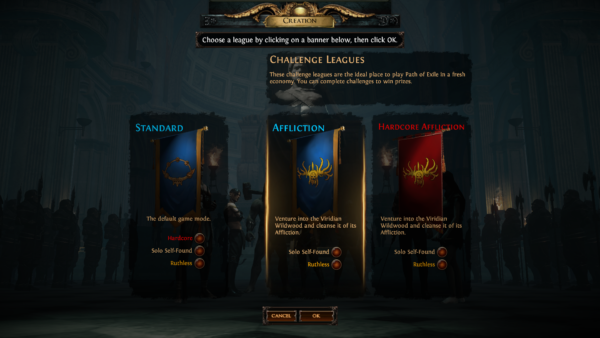
In PoE 2, there are four base game modes confirmed. Standard, Hardcore, Solo Self Found (SSF), and Hardcore SSF (HCSSF).
Standard – The base game with no extra rules. You can trade with other players, play in a party, etc.
Hardcore – The same as Standard, except your character will move to Standard if they die, essentially giving you 1 life.
SSF – You cannot trade or play with other players. Everything you have is found by yourself.
Hardcore SSF – A combination of Hardcore and SSF. If you die in this mode, your character will move to SSF.
Ruthless – This is a PoE1 game mode that severely reduces the drops and greatly raises the difficulty of the game.
At any point, you can migrate your character from SSF to Standard (with or without your loot in the stash). However, to do so in Hardcore, you will need your character to die.
This means you can’t easily transfer your loot over to Standard from Hardcore unless you do so by dying with a character and using their inventory to move stuff over.
Overall, pick the game mode that you think you will enjoy most. For those that enjoy a challenge or are sadistic, pick Hardcore. If you enjoy trading and making money, play in Trade League (more on this in a bit).
Or maybe if you prefer to be a lone wolf, play SSF. For the extra challenge, you can do Hardcore SSF. But, if you’re new and still learning the game, you should pick Trade League for the simplest experience.
Challenge Leagues
In Path of Exile, you may have heard of something called Leagues. Leagues are basically seasonal content releases that add new features to the game. Leagues are new game modes and are essentially new servers. This is where a majority of players play the game. You can think of Standard/Hardcore/SSF/HCSSF as eternal leagues, the resting place for old characters. Some players enjoy building extremely strong characters in Standard, but this is a niche community of players.
When a new League comes out, you won’t have any characters carry over from your previous time spent. As such, everyone will be making new characters during this time, providing a fresh start for players.
For example, they PoE 1 released a League called “Affliction.” When this League launched, you had the option to play Standard Affliction (also referred to as Trade League), Hardcore Affliction, SSF Affliction, and Hardcore SSF Affliction. When the League finishes, your characters will migrate to their respective eternal game modes.
This League system provides seasonal content for players and an opportunity to try something new. Path of Exile isn’t a game where you spend years building up one character, but multiple characters over time. It also provides a fresh economy for the game as everyone restarts from zero. Now that you know the different Modes and Leagues, let’s cover picking your character’s Class.
Character Classes
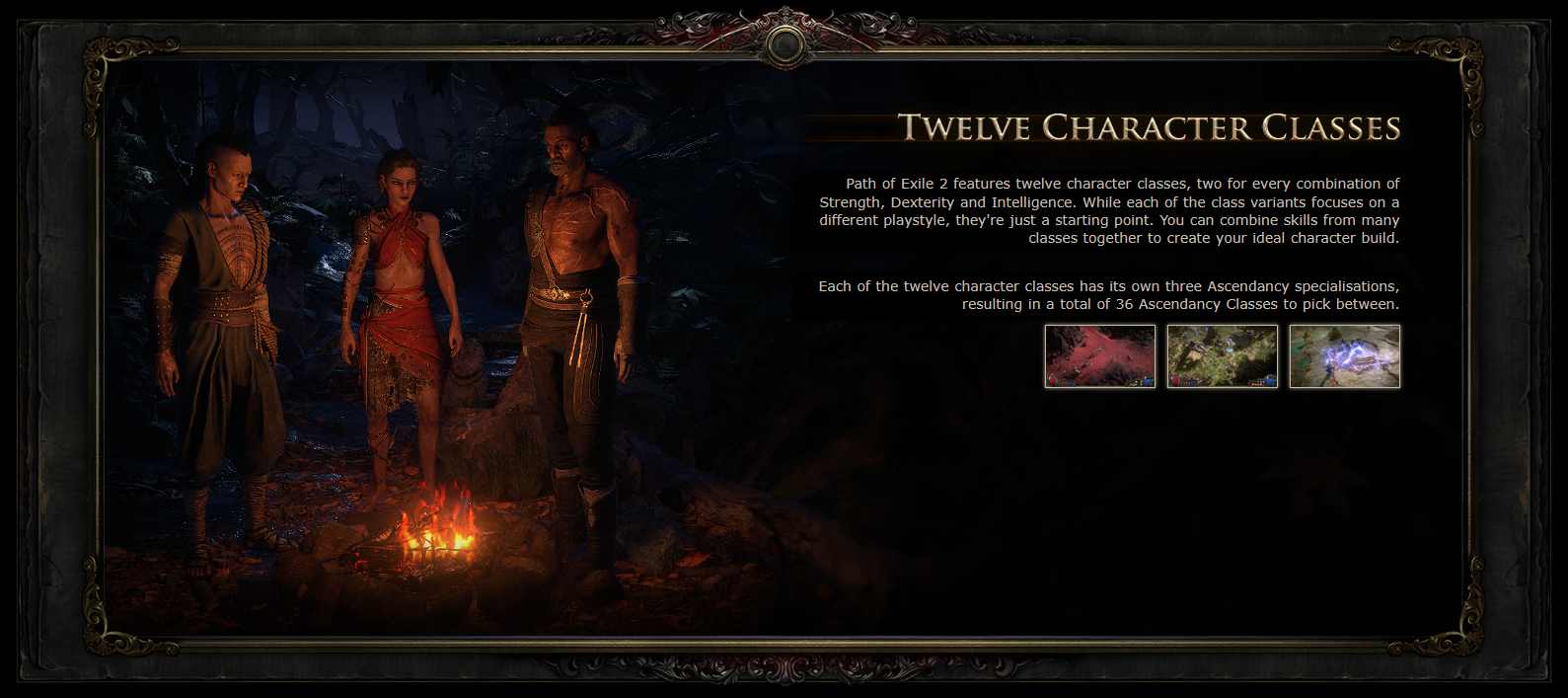
In Path of Exile 2, there are twelve base classes, with two classes representing each Attribute combination. (Strength, Dexterity, Intelligence, Strength/Dexterity, etc).
The Passive Tree in Path of Exile will have 6 starting locations, with each Attribute combination having their own starting position on the tree. (E.g. Marauder and Warrior will start at the same location on the tree)
The Scion was the 7th class introduced in PoE 1 that started at the center of the tree. The Scion will not be playable in PoE 2.
Here’s a list of the classes in PoE 2 and their signature weapon/specialty.
Strength: Marauder – Axes
Strength: Warrior – Maces
Dexterity: Ranger – Bows
Dexterity: Huntress – Spears
Intelligence: Witch – Minions/Occult Spells
Intelligence: Sorceress – Elemental Spells
Str/Dex: Duelist – Swords
Str/Dex: Mercenary – Crossbows
Int/Dex: Shadow – Daggers and Traps
Int/Dex: Monk – Unarmed and Quarterstaves
Str/Int: Templar – Flails
Str/Int: Druid – Shapeshift Spells
Keep in mind that in PoE, characters are not limited by their classes. You can be a Marauder that slings fireballs or a Duelist that fires arrows.
If you want to Shapeshift, you can definitely play a Druid, but maybe you want to be tankier, and decide to play Marauder instead to start closer to the Strength portion of the tree.
These classes provide a strong foundation for builds, so choosing a matching class will be a simple way to progress. However, if you want to go wild with it, you definitely can. Just keep in mind that you’ll need to understand more game mechanics to take advantage of picking an “off class.”
Ascendancy Classes

PoE 1 Ranger Ascendancy Classes
Three Ascendancy Classes are available to each Class. This means there are a total of 36 Ascendancy Classes. These are essentially specializations for your character. Each Ascendancy class has a small passive tree that provides very powerful bonuses. These bonuses are often build defining and are a major reason why you’d pick one class over another.
The details on how to Ascend are yet to be revealed, but they will occur during the campaign.
Passive Skill Tree
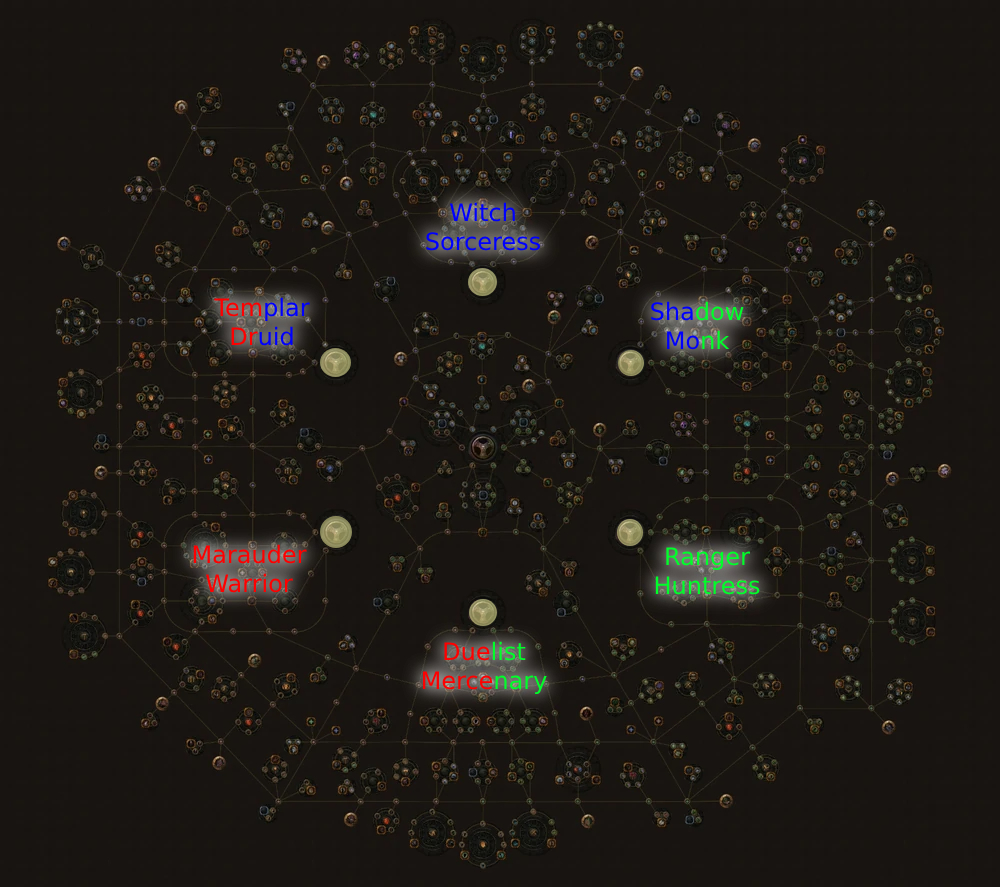
One of the defining features of PoE is the gigantic Passive Skill Tree. As you level up, you will gain points to spend on this tree to grant your character bonuses.
As previously mentioned, your starting location will be based on your class. You can refer to this graphic to see. Intelligence based nodes are at the top third of the tree, Strength on the left, and Dexterity on the right.
This image isn’t taken from PoE 2, but PoE 1. While the exact nodes and tree won’t be the same, the class starting positions will be the same. (Note that the Scion starts in the middle, but won’t be available in PoE 2)
Nodes: Small Passives, Notables, and Keystones
There will be three types of nodes on the Tree.

Small Passives, which as expected, provide small bonuses like Damage, Attributes, Accuracy, Armour, etc.
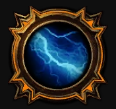
Notables are slightly larger nodes that usually end a chain of Small Passives in a cluster. These clusters on the tree provide a similar bonus to quickly identify which areas you may want to travel to.
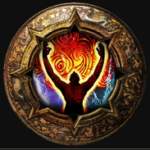
Keystones are the last type of node and are the largest. These Nodes provide powerful effects that can completely alter a character. They also may come with downsides to make up for their powerful effects.
Dual Specialization
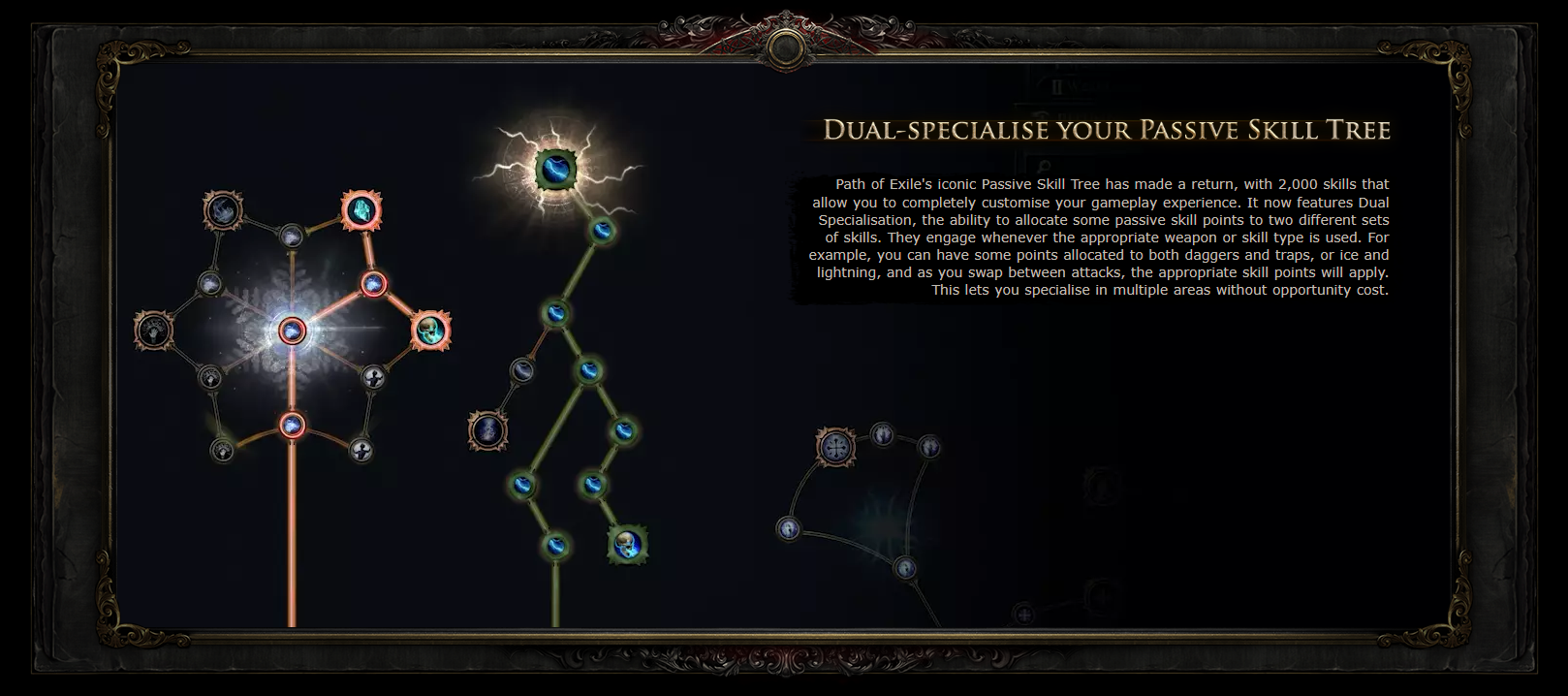
One major change to the passive tree in PoE 2 is the Dual Specialization system. This system allows you to allocate certain points on different nodes. Essentially, you’re almost creating two different passive trees for your character.
By using the Weapon Swap system, your character will automatically match their skills to either Specialization. For example, I can spend 6 points on Cold Damage in the tree and Lightning Damage with the dual specialization. With the Weapon Swap, my Lightning skills will gain their bonus from the tree while my cold skills can benefit from the Cold Damage bonuses.
Only a limited amount of passive points can be allocated this way, earned by using Skill Books you get as quest rewards.
Dodge Roll
The Dodge Roll is a new mechanic coming to PoE 2 that is available by default to every character. As it sounds, it’s a movement skill that lets your character roll in a specific direction using the space bar (default hotkey).
When timed correctly, the Dodge Roll will avoid projectiles and attacks (but you cannot avoid AoE attacks, so roll out of them before they hit). You can also use the Dodge Roll to cancel skill animations if you find yourself in a bad situation.
Rolls cannot be cancelled.
Rolling will not be faster than walking.
Rolling is affected by movement speed.
Life / Mana / Spirit

Like most games, Path of Exile uses Life (Red pool on the left) and Mana (Blue pool on the right). However, PoE 2 is introducing a new resource called Spirit (Yellowish bar above Mana pool).
Life will keep your character alive, Mana is used to cast your skills, and Spirit will be used for persistent effects. Things like permanent buffs, auras, and minions will use the Spirit resource. In PoE 1, auras were used by Reserving a portion of your Life or Mana pool. This would often lead to characters simply not having a Mana Pool and sustaining their skills through other means. With the new Spirit resource, characters will now actually use their Mana as intended, and gain buffs through Spirit.
Every character has a set amount of Spirit. This can be increased through boss rewards or modifiers on items (like on the Sceptre weapon).
For example, a Witch build that focuses on Summoning will likely want to use the Sceptre weapon to increase their Spirit, increasing the amount of permanent minions they can summon.
Skill Gems
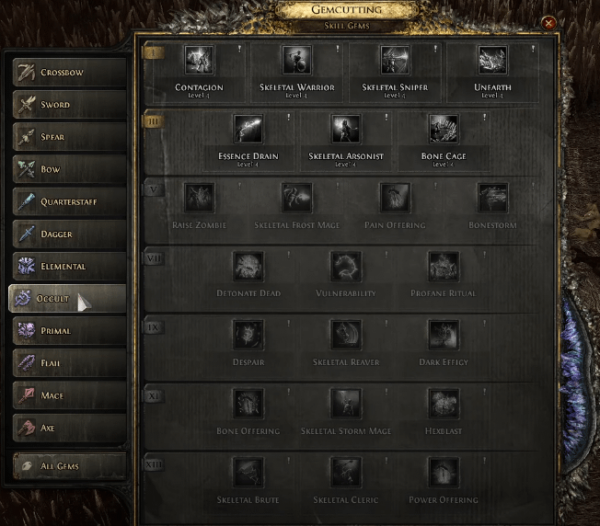
Skill gems are a unique system in Path of Exile. Unlike other games, the skills your character uses come in the form of an item, a Skill Gem. These Skill Gems can be something like summoning a skeleton, shooting a fireball, attacking with a weapon, casting a defensive aura, etc. There will be a ton of different Skill Gems in the game.
Right now, Skill Gems are broken down into 12 subcategories (One matching each class). As previously mentioned, you don’t have to use “Occult” Skill Gems if you’re playing a Witch class character. These are simply the go-to Skill gems to match the intended
Uncut Skill Gems
As you progress through the game, you will find items called “Uncut Skill Gems.” Using this item will allow you to pick any Skill Gem in the game, provided it is high enough level. Some Skill Gems require a certain level, so finding an Uncut Skill Gem early in the game doesn’t mean you’ll have access to every skill just yet.
Furthermore, you can use an Uncut Skill Gem to access any Skill in the game regardless of your class. You can stay within the confines of your Class to get a good idea of what to use, but you can also mix and match many skills throughout the game to make the character just right for you.
Support Gems
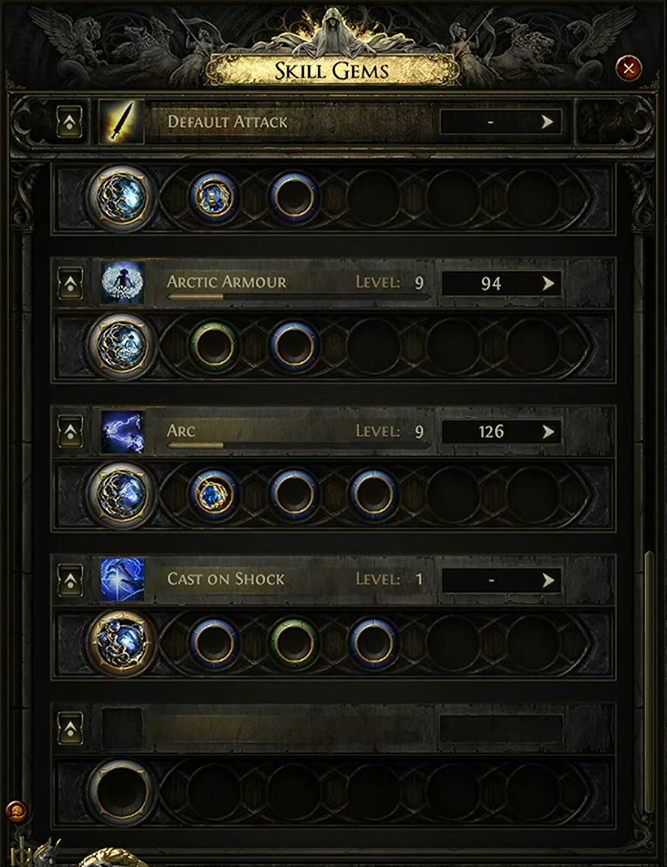
In Path of Exile 2, every character will have access to 9 slots to equip Skill Gems. These Skill Gems are further enhanced by Support Gems. Every Skill Gem can have up to 5 Support Gems. A fully supported Skill Gem is referred to as a “6-link.”
By default, your Skill Gems will have access to a minimum of 2 Support Gems when found. As you progress through the game, you will find a currency that will upgrade the available Support sockets from 2 to 3, 3 to 4, and lastly, 4 to 5. Each of these upgrades will have their own tier of currency to do, with the final upgrade being more rare to find.
Support Gems grant additional effects to your skill, and there will be much to explore when the game releases in Early Access.
More on Gems
Gem Colors and Attributes
Every Gem, both Skill and Support, have a color. Red gems correspond to Strength, Blue to Intelligence, and Green to Dexterity. Skill gems will naturally have an Attribute requirement based on their color.
Support Gems will also affect your Attribute requirement. As you link Support Gems onto a Skill Gem, the total Attribute requirement for the Skill will increase based on the Colors.
The Support Gem Sockets on your Skill Gem will also have a color. For example, the Arc Skill Gem above has 3 Blue support sockets. This means you can socket Blue Support Gems into the sockets.
These colors can be changed using a Currency Item, likely a Chromatic Orb. The Chromatic Orb will be deterministic, but the details have yet to be revealed.
Weapon Swap / Dual Specialization
As previously mentioned, you Skill Gems can also benefit from the Dual Specialization Passive Tree. Every character will have access to two Weapon slots that you can swap between. Your Skill gems can then be assigned to use a specific set of Weapons.
These Weapon swaps will automatically use the Dual Specialization tree, allowing your character more freedom to access different bonuses for different skills.
Meta/Trigger Gems

Meta Gems are special skill gems that can be supported by both Skill and Support Gems. These are also known as Trigger Gems. When a condition is fulfilled, the Meta Gem will cast the supported Skill Gems.
For example, we see a Meta Gem called “Cast on Shock.” When you Shock enough enemies (a status ailment inflicted by Lightning Damage) the Meta Gem will cast any supported Skill Gems.
With a gem like this, you can opt to cast 5 Skill Gems, as that’s the max number of support sockets. Conversely, you can set up a system where you only cast 3 Skill Gems, but the other two Sockets have Support Gems, buffing up those 3 Skill Gems.
Flasks
Flasks are a system in Path of Exile that are essentially potions. There hasn’t been too much information on Flasks in PoE 2, but we can expect most things to carry over from PoE 1.
Characters have 5 Flask slots and there are 3 types of Flasks. Life Flasks, Mana Flasks, and Utility Flasks.
Life Flasks and Mana Flasks are quite self explanatory as they simply regenerate that resource. Utility Flasks, however, provide buffing effects to your character. It’s very likely we’ll see Utility flasks that increase Armour or provide some sort of defensive utility. It’s also likely we’ll see offensive Utility Flasks as well.
Flasks have a set amount of charges they carry, and using Flasks deplete charges. As you kill monsters that are Magic, Rare, or Unique, Flasks will regain charges.
Towns will also have a Well that you can interact with to replenish your Flasks.
Flasks can also be crafted on, providing additional effects. Once again, exact details remain to be seen.
Equipment / Items
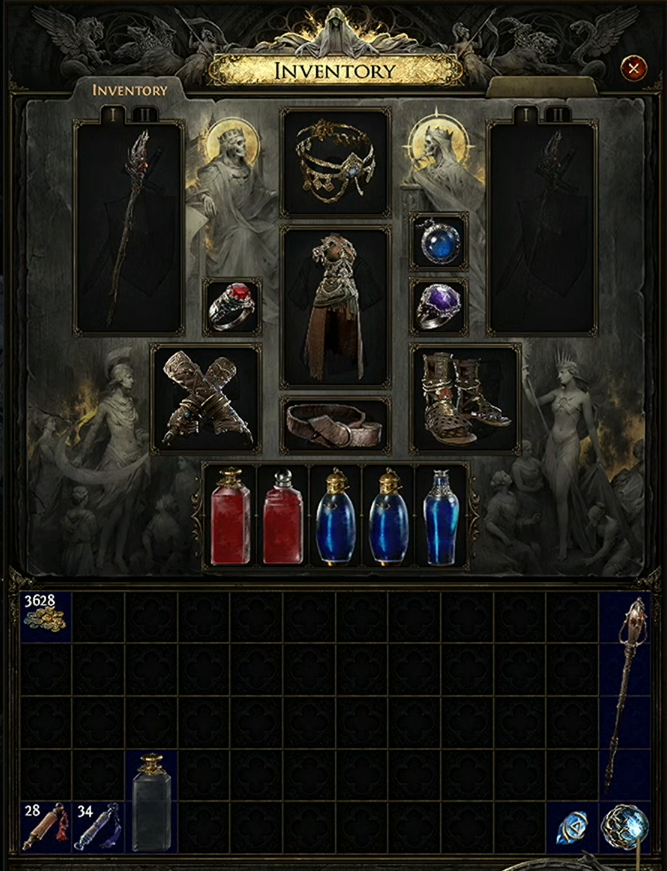
Moving on, let’s talk about Items/Gear/Equipment. PoE is a game with a strong emphasis on loot, and your Gear will contribute immensely to the strength of your character.
By default every character has 9 equipment slots:
Weapon (2Handed/1Hand+1Hand/1H+Off Hand/Bow+Quiver/etc)
Helmet
Chest
Gloves
Boots
Amulet
Ring 1
Ring 2
Belt
I won’t go too in depth describing each of the items, but each item has a set list of possible modifiers. For example, Boots can grant bonus Movement Speed, Chest pieces often give high Armour or Evasion stats, and Weapons will be the bulk of your offensive stats.
Item Modifiers
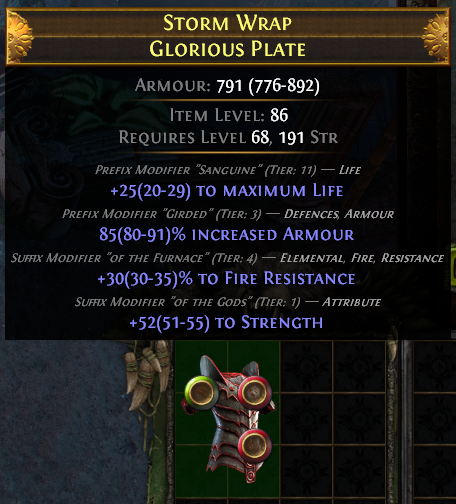
Items in this game grant bonuses called modifiers (also called affixes). Modifiers are split into three subcategories, Implicits, Prefixes, and Suffixes.
Implicit modifiers are what the base item grants, such as the Armour on a Chest or the Physical Damage from a weapon. On top of that, items will also have Prefixes and Suffixes that provide additional modifiers, up to 3 of each.
Modifiers on items are generally only available as a prefix or a suffix, not both. For example, Life on gear is only a Prefix in PoE 1.
I won’t go into further detail as this is mainly just to cover the basics. The items and crafting in PoE goes quite in depth and will require a whole article just to tackle.
Item Rarity
There are 4 tiers of Item Rarity:
Normal: A Normal rarity item is just the base item. There will be an implicit depending on the base item, but no prefixes/suffixes.
Magic: A Magic rarity item will have up to 1 Prefix and 1 Suffix.
Rare: A Rare item can have up to the maximum of 3 Prefixes and 3 Suffixes.
Unique: These items are special items that grant powerful effects, but at the cost of not being craftable. While some currency items can affect Unique equipment, you can’t for example add or change the prefixes/suffixes to something else.
A strong character will usually look to use some Unique items and rest will be Rare items. This is because many stats like Life or Resistances might not be present on Unique items. In order to ensure your character can survive, you will need to use Rare items to get those stats.
Note: Flasks cannot be Rare, only Normal, Magic or Unique. (From PoE 1)
Defences
Let’s quickly cover some of the important stats you should know about. With so many things in the game, it can get overwhelming, so I’ll boil down the few most important factors.
Resistances
Without a doubt, the most important layer of defense are Resistances. These separate into Fire Resistance, Cold Resistance, Lightning Resistance, and Chaos Resistance.
By default, each character can have up to 75% Resistance, effectively reducing the damage you take from these sources by 75%. As you play through the game, you will want to increase these stats as much as possible until you reach the cap. This is especially important if you’re about to face a boss that deals a specific type of damage.
Resistances can be unassuming, but they are very important. For example, 70% vs 75% might not seem that big of a deal, it’s just 5%. However, look at it this way.
With 75% Resistance, you’ll take 25 damage from a hit of 100. With 70%, you’ll be taking 30 damage. Taking 30 damage from 25 is a 20% damage increase from enemies.
You don’t need to immediately raise your Resistances to 75% right when you start, but you should actively look to cap your Resistances. If you find yourself dying too much in the campaign or to a boss, check to see if your Resistances are capped.
Note: It can be difficult to cap your Chaos Resistance early in the game, so don’t worry about this one too much, just try to cap this as you approach a Chaos Damage boss or are approaching the endgame.
Damage Mitigation
If you noticed, Resistances only apply to elemental damage (from spells and hits) or Chaos damage. You will need some sort of way to mitigate the damage you take from Physical hits. For this, each Attribute brings its own solution.
Strength: Life and Armour
Dexterity: Evasion
Intelligence: Energy Shield
By default, these attributes naturally raise these defensive stats. Life is great for mitigating all sources of damage as it’s universally applicable.
Energy Shield

The same can be said for Energy Shield (ES). ES is similar to life, as it essentially increases your Health pool, but, it regenerates differently. Life can be recovered with Flasks and continuously over time with Life Regeneration. ES will regenerate quickly if you haven’t taken damage recently. (There are sources of ES Regeneration that will let it continuously regenerate)
Another difference is that Chaos Damage bypasses Energy Shield. However, Chaos Inoculation (a Keystone) allows you to be immune to Chaos Damage at the cost of reducing your Life to 1. This is how some characters focus only on Energy Shield instead of Life.
Armour and Evasion
Lastly, let’s briefly cover Armour and Evasion. Armour will mitigate physical damage based on the amount of damage and amount of Armour you have. Evasion, like it sounds, will provide a chance to evade damage completely.
Once again, these mechanics have more depth to them, but that’s the basic gist of things. If you’re a Marauder starting in the Strength area of the tree, you likely will focus on Armour and Life for your defensive stats. For a Ranger, Life and Evasion can be a focus. If you’re a Witch, Life and/or Energy Shield, and so on.
If you want to build an extremely defensive character, combining defensive stats can be strong as well. By having both Armour and Evasion, you effectively raise your HP more than simply investing in one stat. However, this will come at the expense of using stats or passive tree points on more offensive stats.
There are much more in depth methods of increasing survivability, but this is simply the baseline on how to not die.
Offences
Damage in PoE is an extremely in-depth topic, but I’ll try to cover the basics here. The things I cover here won’t be true for every case, but are applicable in most situations.
Damage Types
There are four damage types in the game:
Attacks – Deals damage mostly based on your Weapon
Spells – Deal damage mostly based on the Gem and Gem level
Damage over Time – Similar to Spells, scales based on the Gem and level
Secondary Damage – Are scaled by specific bonuses
Attacks
Attacks are Skill Gems that will deal damage largely based on your Weapon. For example, you may have a skill called Spearfield that strikes with your Weapon. As such, your Weapon will contribute to a majority of your damage.
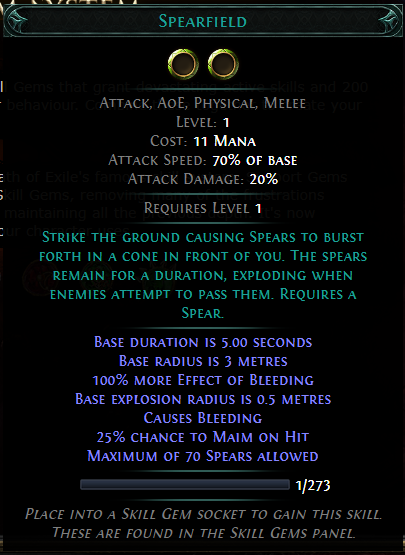
Another important thing to keep in mind is that modifiers on your Weapon are usually “local.” This means that if your weapon has the modifier “increased physical damage,” what that is doing is scaling the base damage of your weapon higher. (The same is also true for local defense modifiers on equipment)
This is extremely important to scale the damage of your Attacks, as your weapon and other sources of damage will scale multiplicatively.
Let’s give an example with simple numbers:
Let’s say a Weapon has a base physical damage of 100. The Weapon has no modifiers increasing the damage.
If the passive tree has 100% increased physical damage, the resulting damage will be 200.
100 x (1 + 100%) = 200
If the Weapon has 50% increased physical damage and the passive tree has 50% increased physical damage, the resulting damage will be 225.
[100 x (1 + 50%)] x (1 + 50%) = 225
The same is true for things like Critical Strike Chance and other modifiers on your Weapon/other sources.
Spells
Spells differ greatly from Attacks. They have their own Base damage on the Skill Gem itself and their own Base Crit Chance.
In PoE 2, weapon types such as Wands don’t have Attack stats, so you don’t need to worry about certain modifiers applying to your Spells or not. This was sometimes a concern in PoE 1. (For example, in PoE 1, increased crit chance on your Weapon would not affect your spells)
Spells are often scaled further with modifiers that provide +1 level to gems. This further increases the base damage of your Skill Gem, providing a strong bonus.
Damage over Time (DoT)
DoT is usually similar to Spells in that they are scaled mostly by the Skill Gem itself. DoT damage is usually present in sources of Fire Damage (Ignite), Physical Damage (Bleed), or Chaos Damage.
Secondary Damage
Secondary Damage is a special case that applies to certain Skill Gems. For example, in PoE 1, Herald of Ash is an Aura Skill Gem that deals fire damage in an area around an enemy when they die. To scale this damage, you will specifically need modifiers or nodes that say things like “increased fire damage” or “increased area damage.” However, since this damage isn’t a spell or attack, it won’t benefit from “increased spell damage” or “increased attack damage.”
Campaign
In PoE, the Campaign is essentially the story. Each character will need to progress through the Campaign in order to access endgame systems. The PoE 2 Campaign will consist of 6 acts (or chapters).
As with many games, you’ll progress through doing Quests and leveling your character along the way. Here are some additional details about the Campaign.
Optional Quests can grant permanent bonuses such as Attributes or more Spirit. You will need to do this on each character you play.
When you die, skills that use Spirit like Auras will remain on your character. (This is a QoL change from PoE 1)
In the Campaign, there is no penalty for dying. There will be an XP penalty on death in the endgame.
Bosses in the Campaign will need to be done in one attempt. You will not be able to portal back to town to refill your Flasks and continue the fight. If you die in a Boss fight, the Boss will reset.
Currency Items
We’re nearing the end of the guide finally, so let’s briefly cover Currency Items. In PoE 1 there was no Gold or traditional currency in the game. Instead, Currency revolved around crafting items. This means that the currency in the game is also the items you use to craft on equipment.
The items that provided stronger crafting effects would then be worth more compared to other Currency items.
However, PoE 2 is releasing with Gold, which is a huge change for existing PoE players. Here’s a quick rundown of how Gold is currently working/envisioned.
Gold
Gold will drop throughout the game and be automatically looted within a small vicinity of your character. You’ll use Gold at NPC vendors to buy or gamble items. Gold cannot be traded or earned outside of simply playing the game.
Furthermore, there is discussion about how Gold can potentially be used as a fee for using the trading system. In PoE 1 you needed to look up an item you wanted on the trade website, message the person online, party up, and trade in game.
This leads to a lot of inefficiencies in the trading system of PoE 1. With Gold, you can automate small trades between currencies, but will still need to go onto the online marketplace to look for equippable items like weapons/armour.
In PoE 2, Grinding Gear Games is looking at potentially using instant buy features and adding more QoL features to trade. This will likely be powered by Gold, which will be used by the Buyer to enact a trade. While you won’t be buying items with Gold, the Gold will simply allow you to interact with Trade, letting you purchase items from other players with currency.
Closing Words
This wraps up my “brief” Path of Exile 2 beginner guide. A lot of details are yet to be revealed, and as the Beta nears, I’ll definitely be updating this guide. As you can see from the length of this article, even the basics can be a lot of information.
Overall, you don’t need to learn every little thing to enjoy Path of Exile. Even going in completely blind can be an enjoyable experience. As you play more and more, you’ll learn more things about the game, letting you build stronger characters or progress faster.
In the meantime, you can also give Path of Exile 1 a try. Everything won’t be the same, but you’ll get a good feel of the series by doing so.